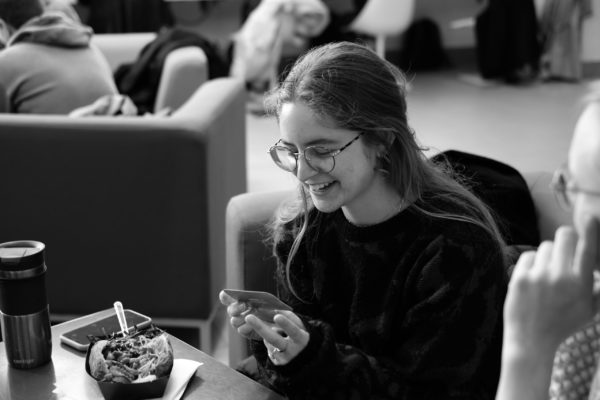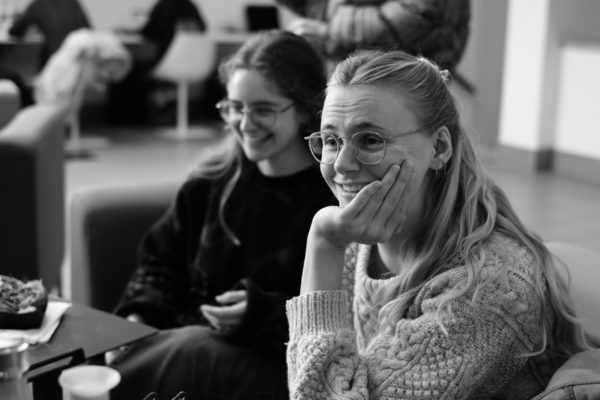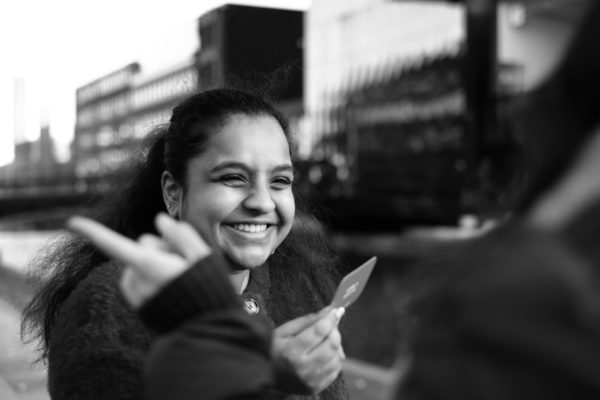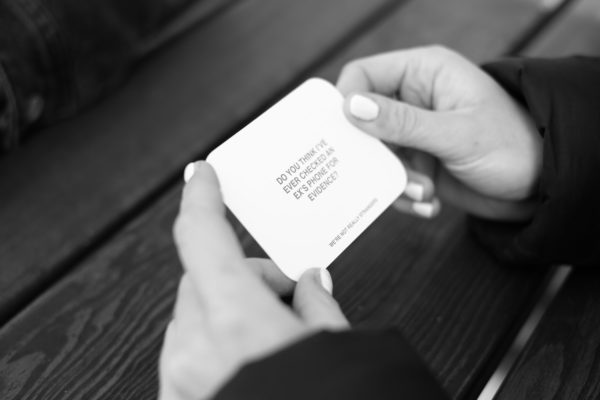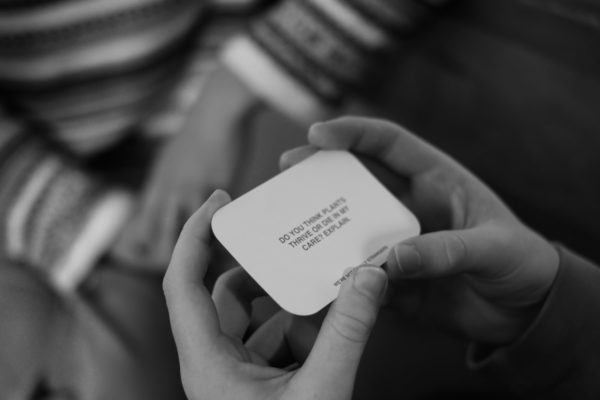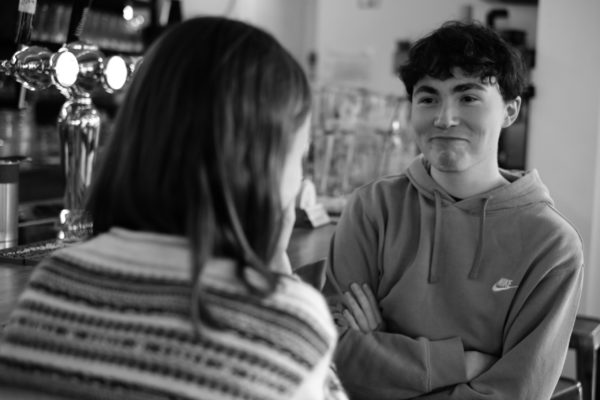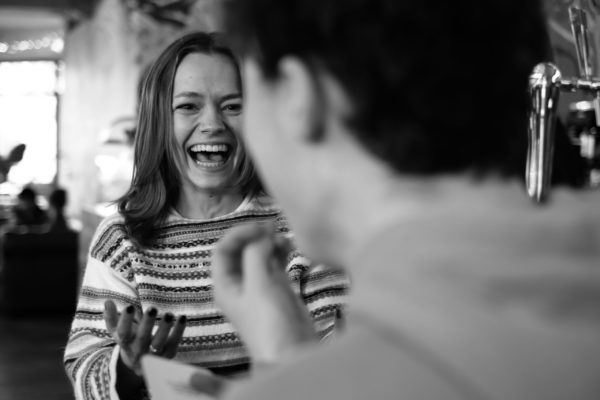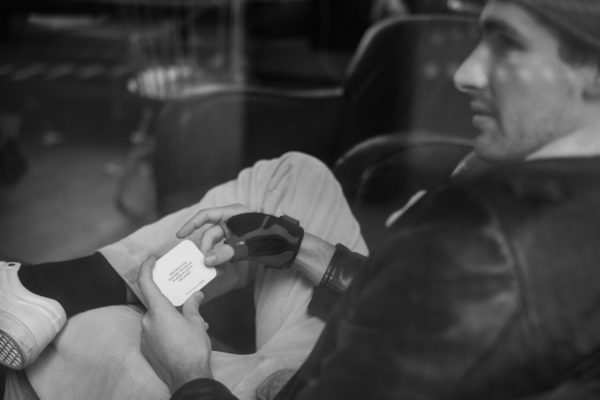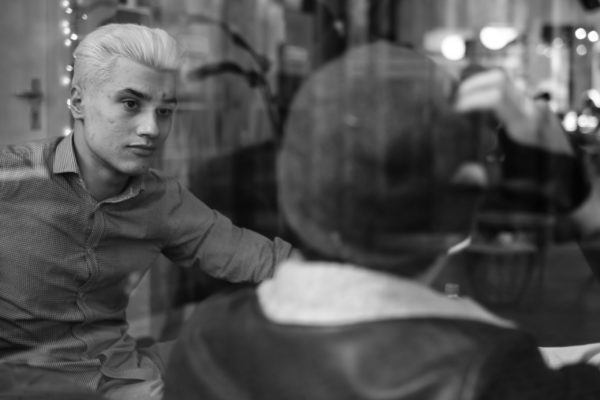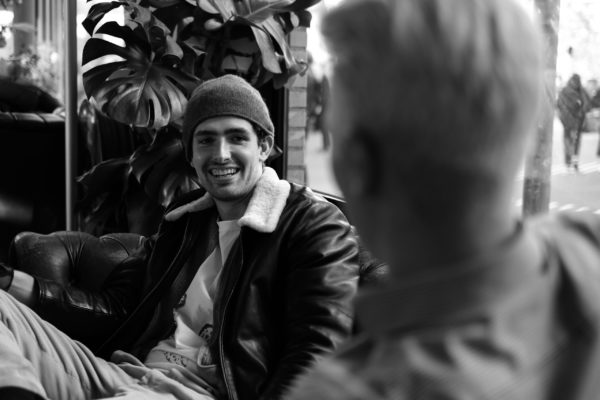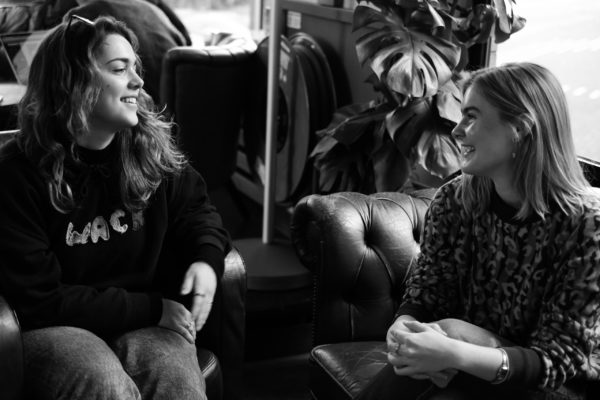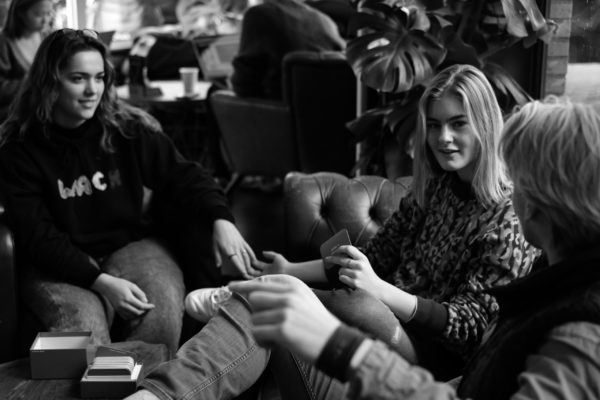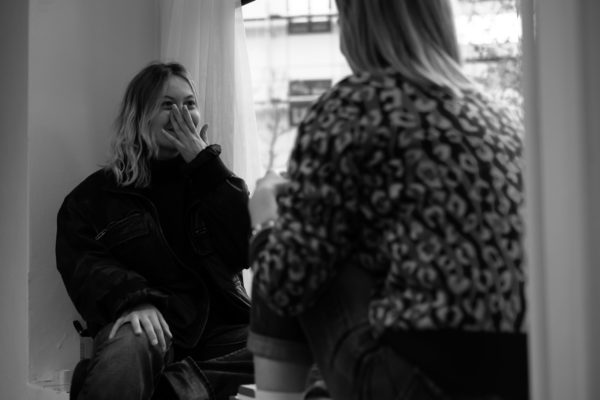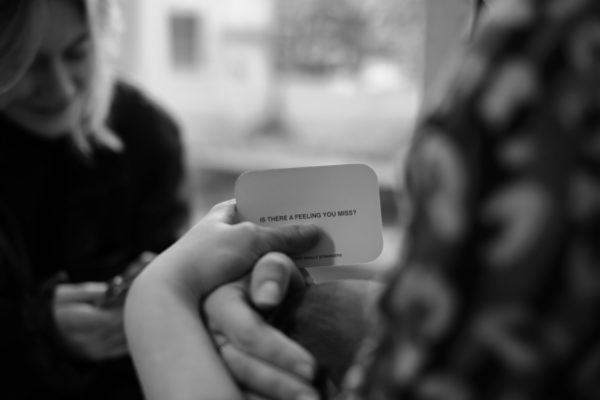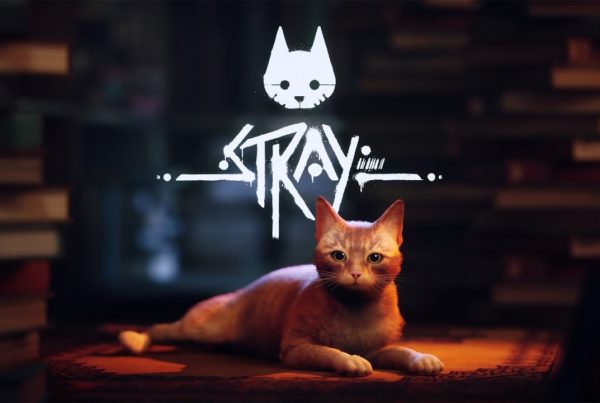
Truth or Dare? Did the question send a tingle down your spine, do you hear the echoes of giggling tweens? It’s hard to forget the feeling of one of the classic middle school, and perhaps highschool, party games. Or the icebreakers for every introductory lesson of a class, starting off with Two Truths and One Lie. I still seem to struggle with finding something remotely interesting to reveal about my life despite having played it time and time again. The beauty of games like this is that they get you to reveal something about yourself. Well, I suppose with Truth or Dare you have more of a choice. But, if you were like me, I much preferred hearing the responses of the truths that sparked a buzz of conversation.
Photo Series taken by Pika Ivana Kostanjšek
If that struck a chord with you, then maybe closeness games, like the one featured in this photo series, can be your newest obsession. We’re Not Really Strangers, WNRS, is a game designed by Koreen, a model and artist based in LA, with one mission – enabling people to create genuine and meaningful connections with others. The primary edition of the game is designed around three levels, the first focusing on how we perceive one another, for instance first impressions. The second level explores connection, with the warranted and catchy tag-line, ‘warning: feelings may arise’. Lastly, the third one, centered around reflection upon the relationship between the players after having learned more about each other. Upon going through these three levels, any walls present are broken down and at last, you and I are no longer strangers.
The revealing questions, especially in Level 2, call for high self-disclosure and according to research by Aron, Melinat, Aron, Vallone, & Bator (1997, as cited in Sprecher, Treger & Wondra, 2012), high self-disclosure leads to an increase in liking and closeness between people. When listening to the American Psychological Association’s podcast, Speaking of Psychology, the episode featuring Dr. Arthur Aron on ‘What Makes Love Last?’, I came across Aron’s ‘36 questions that lead to love’. In his words, this is a set of questions designed to create and measure closeness in experimental settings. An interesting aspect to this is that when they had two couples carry out the session together, it not only bonded the group of four, but also increased closeness within the couples, and by extension, love. Though it may be a set of questions designed for labs, upon trying it out with loved ones, I can confirm they still result in curiosity and laughter. But, what is it about self-disclosure that can draw people closer together?
Self-disclosure plays an integral role in how relationships unfold and grow due to the nature of a ‘give and take’ interaction – when one discloses something about themselves, it is expected that the other will do the same (Frothingham, 2022). Maybe it is a personal preference, but I almost find it uncomfortable to simply just listen to someone opening up about themselves without engaging and offering a personal connection to the subject matter. Interestingly, with more intimate self-disclosure, closeness between people can increase, but at the same time mutual liking can also decrease, depending on if the context of sharing is ‘appropriate’ (Lin & Utz, 2017). I suppose if you have agreed to play a game such as this one, the intention is to dive into the deep and personal, so the context would be considered ‘appropriate’.
During the photoshoot, we attempted to get as many pairs to participate as we could, but we got the chance to have one pair play on for longer than the rest. After their session, I had asked them how they felt about the game. Laughing, they said “it wasn’t as bad as I thought it would be”. I asked if they felt like it did indeed bring them closer, and after thinking about it for a moment, they said maybe not closer but it helped them gain a better insight into how they view one another. Their favorite responses were for the question ‘What is my defining characteristic?’, and I must say that it was a personal favorite of mine as well. Maybe it’s something to ask most people you know.
I’ve played other games before, with the premise of building closeness, ranging from party games to decks of cards with conversation starters from other companies such as The School of Life. While the idea of the game is to bring people together, oftentimes there are those in the room who would like to cherry-pick and get to the ‘juicy’ questions. Some find that such questions are more entertaining to hear the answer to, it’s ‘riskier’ if one were to answer honestly, compared to a more mundane question. I imagine it’s about the building of trust – if you disclose something personal, there is a sense of satisfaction that the other person believes that your ‘secret’ is safe with them. Alternatively, maybe it is curiosity because it feels as though something is on the line if we were to give this information away. It reminded me of the enjoyment in hearing about gossip, be it positive or negative. From an evolutionary perspective, gossip can be seen as a tool to bond, maintain social groups, and to learn from each other by spreading information to large networks (Gottfried, 2019). So, while we may not want to be gossiped about, there are some benefits in engaging in similar activities.
Nevertheless, I believe that these closeness games work best if you go into it with the intended goal – to grow closer to one another and develop the connection, rather than just learn the next exciting detail about one another. There is something heart-warming about learning something new about someone you think you already know everything there is to know about. As you take in this piece, and the lovely photo series that goes with it, I’d like to leave you with a level 1 question: do you think you would give a closeness game a chance? <<
We’d like to thank Isabelle Nic Craith, Ella Goldfarb, Charlotte Klimek, Ayla Farzali, Austin Irwin, Virginia Corno, Luca Rieger, Alec McGinnell, Orlando Avalon, Nicholas Steinmann, Alice Maziere, Finn Loots, and Trini Anwandter Díaz, for participating in the photoshoot.
References
-
Frothingham, M. B. (2022). How Self-Disclosure Affects Relationships. https://www.simplypsychology.org/how-does-self-disclosure-influence-relationships.html
-
Gottfried, S. (2019). The Science Behind Why People Gossip—And When It Can Be a Good Thing. Time. https://time.com/5680457/why-do-people-gossip/
-
Lin, R., & Utz, S. (2017). Self-disclosure on SNS: Do disclosure intimacy and narrativity influence interpersonal closeness and social attraction?. Computers in Human Behavior, 70, 426-436.
-
Sprecher, S., Treger, S., & Wondra, J. D. (2013). Effects of self-disclosure role on liking, closeness, and other impressions in get-acquainted interactions. Journal of Social and Personal Relationships, 30(4), 497–514. https://doi.org/10.1177/0265407512459033
Truth or Dare? Did the question send a tingle down your spine, do you hear the echoes of giggling tweens? It’s hard to forget the feeling of one of the classic middle school, and perhaps highschool, party games. Or the icebreakers for every introductory lesson of a class, starting off with Two Truths and One Lie. I still seem to struggle with finding something remotely interesting to reveal about my life despite having played it time and time again. The beauty of games like this is that they get you to reveal something about yourself. Well, I suppose with Truth or Dare you have more of a choice. But, if you were like me, I much preferred hearing the responses of the truths that sparked a buzz of conversation.
Photo Series by Pika Ivana Kostanjšek
If that struck a chord with you, then maybe closeness games, like the one featured in this photo series, can be your newest obsession. We’re Not Really Strangers, WNRS, is a game designed by Koreen, a model and artist based in LA, with one mission – enabling people to create genuine and meaningful connections with others. The primary edition of the game is designed around three levels, the first focusing on how we perceive one another, for instance first impressions. The second level explores connection, with the warranted and catchy tag-line, ‘warning: feelings may arise’. Lastly, the third one, centered around reflection upon the relationship between the players after having learned more about each other. Upon going through these three levels, any walls present are broken down and at last, you and I are no longer strangers.
The revealing questions, especially in Level 2, call for high self-disclosure and according to research by Aron, Melinat, Aron, Vallone, & Bator (1997, as cited in Sprecher, Treger & Wondra, 2012), high self-disclosure leads to an increase in liking and closeness between people. When listening to the American Psychological Association’s podcast, Speaking of Psychology, the episode featuring Dr. Arthur Aron on ‘What Makes Love Last?’, I came across Aron’s ‘36 questions that lead to love’. In his words, this is a set of questions designed to create and measure closeness in experimental settings. An interesting aspect to this is that when they had two couples carry out the session together, it not only bonded the group of four, but also increased closeness within the couples, and by extension, love. Though it may be a set of questions designed for labs, upon trying it out with loved ones, I can confirm they still result in curiosity and laughter. But, what is it about self-disclosure that can draw people closer together?
Self-disclosure plays an integral role in how relationships unfold and grow due to the nature of a ‘give and take’ interaction – when one discloses something about themselves, it is expected that the other will do the same (Frothingham, 2022). Maybe it is a personal preference, but I almost find it uncomfortable to simply just listen to someone opening up about themselves without engaging and offering a personal connection to the subject matter. Interestingly, with more intimate self-disclosure, closeness between people can increase, but at the same time mutual liking can also decrease, depending on if the context of sharing is ‘appropriate’ (Lin & Utz, 2017). I suppose if you have agreed to play a game such as this one, the intention is to dive into the deep and personal, so the context would be considered ‘appropriate’.
During the photoshoot, we attempted to get as many pairs to participate as we could, but we got the chance to have one pair play on for longer than the rest. After their session, I had asked them how they felt about the game. Laughing, they said “it wasn’t as bad as I thought it would be”. I asked if they felt like it did indeed bring them closer, and after thinking about it for a moment, they said maybe not closer but it helped them gain a better insight into how they view one another. Their favorite responses were for the question ‘What is my defining characteristic?’, and I must say that it was a personal favorite of mine as well. Maybe it’s something to ask most people you know.
I’ve played other games before, with the premise of building closeness, ranging from party games to decks of cards with conversation starters from other companies such as The School of Life. While the idea of the game is to bring people together, oftentimes there are those in the room who would like to cherry-pick and get to the ‘juicy’ questions. Some find that such questions are more entertaining to hear the answer to, it’s ‘riskier’ if one were to answer honestly, compared to a more mundane question. I imagine it’s about the building of trust – if you disclose something personal, there is a sense of satisfaction that the other person believes that your ‘secret’ is safe with them. Alternatively, maybe it is curiosity because it feels as though something is on the line if we were to give this information away. It reminded me of the enjoyment in hearing about gossip, be it positive or negative. From an evolutionary perspective, gossip can be seen as a tool to bond, maintain social groups, and to learn from each other by spreading information to large networks (Gottfried, 2019). So, while we may not want to be gossiped about, there are some benefits in engaging in similar activities.
Nevertheless, I believe that these closeness games work best if you go into it with the intended goal – to grow closer to one another and develop the connection, rather than just learn the next exciting detail about one another. There is something heart-warming about learning something new about someone you think you already know everything there is to know about. As you take in this piece, and the lovely photo series that goes with it, I’d like to leave you with a level 1 question: do you think you would give a closeness game a chance? <<
We’d like to thank Isabelle Nic Craith, Ella Goldfarb, Charlotte Klimek, Ayla Farzali, Austin Irwin, Virginia Corno, Luca Rieger, Alec McGinnell, Orlando Avalon, Nicholas Steinmann, Alice Maziere, Finn Loots, and Trini Anwandter Díaz, for participating in the photoshoot.
References
-
Frothingham, M. B. (2022). How Self-Disclosure Affects Relationships. https://www.simplypsychology.org/how-does-self-disclosure-influence-relationships.html
-
Gottfried, S. (2019). The Science Behind Why People Gossip—And When It Can Be a Good Thing. Time. https://time.com/5680457/why-do-people-gossip/
-
Lin, R., & Utz, S. (2017). Self-disclosure on SNS: Do disclosure intimacy and narrativity influence interpersonal closeness and social attraction?. Computers in Human Behavior, 70, 426-436.
-
Sprecher, S., Treger, S., & Wondra, J. D. (2013). Effects of self-disclosure role on liking, closeness, and other impressions in get-acquainted interactions. Journal of Social and Personal Relationships, 30(4), 497–514. https://doi.org/10.1177/0265407512459033

